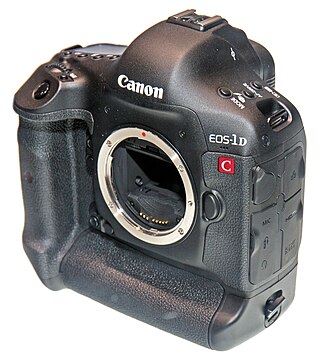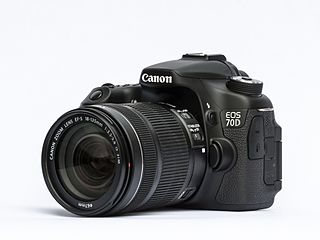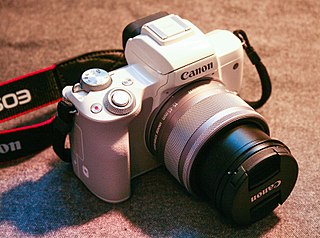
Canon EOS is an autofocus single-lens reflex camera (SLR) and mirrorless camera series produced by Canon Inc. Introduced in 1987 with the Canon EOS 650, all EOS cameras used 35 mm film until October 1996 when the EOS IX was released using the new and short-lived APS film. In 2000, the D30 was announced, as the first digital SLR designed and produced entirely by Canon. Since 2005, all newly announced EOS cameras have used digital image sensors rather than film. The EOS line is still in production as Canon's current digital SLR (DSLR) range, and, with the 2012 introduction of the Canon EOS M, Canon's mirrorless interchangeable-lens camera (MILC) system. In 2018 the system was further extended with the introduction of the EOS R camera, Canon's first full frame mirrorless interchangeable lens system.

The EF lens mount is the standard lens mount on the Canon EOS family of SLR film and digital cameras. EF stands for "Electro-Focus": automatic focusing on EF lenses is handled by a dedicated electric motor built into the lens. Mechanically, it is a bayonet-style mount, and all communication between camera and lens takes place through electrical contacts; there are no mechanical levers or plungers. The mount was first introduced in 1987.

The Canon EF-S lens mount is a derivative of the EF lens mount created for some Canon digital single-lens reflex cameras with APS-C sized image sensors. It was released in 2003. Cameras with the EF-S mount are backward compatible with the EF lenses and, as such, have a flange focal distance of 44.0 mm. Such cameras, however, have more clearance, allowing lens elements to be closer to the sensor than in the EF mount. Only Canon cameras released after 2003 with APS-C sized sensors support the EF-S mount.

Digital Imaging Integrated Circuit is Canon Inc.'s name for a family of signal processing and control units for digital cameras and camcorders. DIGIC units are used as image processors by Canon in its own digital imaging products. Several generations of DIGICs exist, and are distinguished by a version number suffix.

The Canon EOS 40D is a 10.1-megapixel semi-professional digital single-lens reflex camera. It was initially announced on 20 August 2007 and was released at the end of that month. It is the successor of the Canon EOS 30D, and is succeeded by the EOS 50D. It can accept EF and EF-S lenses. Like its predecessor, it uses an APS-C sized image sensor, resulting in a 1.6x field of view crop factor.
Vincent Laforet is a French-American director and photographer. Laforet shared the 2002 Pulitzer Prize for Feature Photography with four other photographers as a member of The New York Times staff's coverage of the post 9/11 events overseas that captured "the pain and the perseverance of people enduring protracted conflict in Afghanistan and Pakistan." In 2006, Laforet became the Times' s first national contract photographer. He has been sent on assignment by Vanity Fair, The New York Times Magazine, National Geographic, Sports Illustrated, Time, Newsweek, and Life. He is represented by the Stockland Martel agency.

The Canon EOS 50D is a 15.1-megapixel digital single-lens reflex camera. It is part of the Canon EOS line of cameras, succeeding the EOS 40D and preceding the EOS 60D.

The Canon EOS 7D is a high-end APS-C digital single-lens reflex camera made by Canon. It was announced on 1 September 2009 with a suggested retail price of US$1,699, and was marketed as a semi-professional DSLR camera.

The EOS-1D Mark IV is a professional 16.1 effective megapixels digital single lens reflex camera (DSLR) camera body produced by Canon. The EOS-1D Mark IV is the successor of the Canon EOS-1D Mark III and was announced on 20 October 2009, just four days after Nikon announced the D3s. It used to be the only Canon APS-H format DSLR to feature HD video recording at 1080p resolution.

The Canon EOS-1D C is an 18.1-megapixel CMOS digital single-lens reflex camera made by Canon in the Cinema EOS range. It shares many features with the Canon EOS 1D X. It was publicly announced on April 12, 2012, and was released in March 2013 with suggested retail price of US$15,000. The Canon EOS-1D C is stated to be the world's first 4K resolution DSLR camera.

The EOS C500 is a digital cinema camera released by Canon in August 2012. The camera is offered with the option of Canon EF or Arri PL mounts. As of 2017, the camera has dropped significantly in price.

The Canon Cinema EOS autofocus digital photographic and cinematographic SLR and mirrorless interchangeable lens camera system was introduced in late 2011 with the Canon EOS C300 and followed by the Canon EOS C500 and Canon EOS 1D C in early 2012.

The Canon EOS 70D is a digital single-lens reflex camera by Canon publicly announced on July 2, 2013 with a suggested retail price of $1,199. As a part of the Canon EOS two-digit line, it is the successor to the EOS 60D and is the predecessor of the EOS 80D.

The EOS C100 is a digital cinema camera made by Canon, announced on August 29, 2012. It was the third camera from the Canon Cinema EOS line to be released, and is the budget camera in the range, being less expensive than both the EOS C300 and EOS C500, going on sale at a recommended price of $7,999. However, unlike the other models, it only shoots in Full HD.
The Canon EOS C300 Mark II is Canon's update to its first generation cinema camera, the Canon C300, and is part of the Canon Cinema EOS line. Notable new features compared to the previous model are the implementation of a sensor capable of a 15-stops of dynamic range, 4K XFAVC and 12-bit internal recording, color matrices, and the ability to record raw motion video via external recorder.

The Canon EOS M50, called Canon EOS Kiss M in Japan, is a digital mirrorless interchangeable-lens camera announced by Canon on February 25, 2018 and sale began on March 23, 2018.

The Canon RF lens mount is an interchangeable-lens mount developed by Canon for its full-frame mirrorless interchangeable-lens cameras, and featured first by the EOS R, followed by the EOS RP. The RF mount was announced in September 2018. In May 2022, Canon announced APS-C EOS R cameras and RF-S lenses designed for these cameras.

The Canon EOS M200 is a digital mirrorless interchangeable-lens camera first announced by Canon Inc. on September 25, 2019. Canon EOS M200 incorporates the proprietary image processor that allows the camera to capture still images up to 6.1 fps using the fixed focus and 4 fps burst mode. The EOS M200 can be connected to all EF, EF-S and TS-E lenses with an available adapter.
The Canon EOS C300 Mark III is Canon's second update to its first generation cinema camera, the Canon C300, and is part of the Canon Cinema EOS line. Its innovation was mainly a shift from the DIGIC-V to the DIGIC-VII processor. It was released in 2020.
















